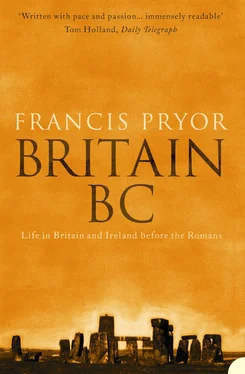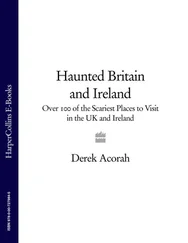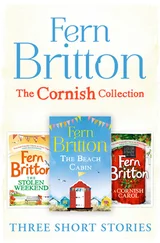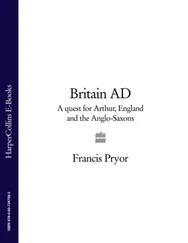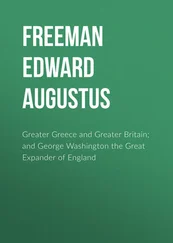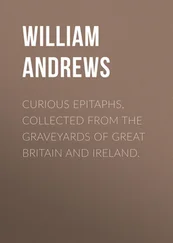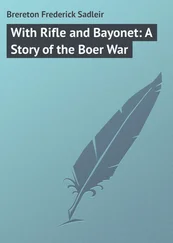Both styles of structure are lightweight and appropriate to people whose pattern of life requires movement through the landscape. Can we call them houses? I don’t see why not. A house is where people choose to live. As soon as we start to talk about ‘huts’ – or worse, ‘shacks’ – we do these buildings a disservice. The small structure within the four gullies at Mount Sandel is undoubtedly a tent-house, the other is a house, albeit a lightweight one. I strongly dislike the term ‘hut’, which I see in the archaeological literature far too often. Huts are for wheelbarrows and garden tools, not for people.
We’ve looked at Mesolithic settlements in England and Ireland, but what was happening further north, in Scotland – was it too cold for settlement in postglacial times? The answer is that it wasn’t; Scotland has produced plentiful evidence of life in the period. One of the most revealing sites was excavated by John Coles, who lectured to me on the Palaeolithic at Cambridge and co-authored the standard textbook of the day. 27 He also lectured on the European Bronze Age, and a few years later co-authored another standard work. 28 At the time he was busily engaged in experimental archaeology, and was dipping his toes into the waters of wetland archaeology, which posterity will probably judge to have been his major contribution. So he’s a man of many parts, which is perhaps why he was invited to take over an existing Mesolithic excavation at Morton, in the Kingdom of Fife, in 1967. The main dig took place in 1969 and 1970. 29
I should perhaps note here that we still know of no evidence for postglacial occupation in Scotland before about 9000 BC. To the best of my knowledge the earliest site on the mainland is currently Cramond, near Edinburgh, which has produced radiocarbon dates from hazelnut shells to around 8500 BC. 30 This is remarkably early, given the fact that it is generally agreed that most of Scotland would still have been uninhabitable before around 9600 BC.
Like most other Mesolithic sites, Morton shows clear evidence for more than one episode of occupation, and there are at least two centres of interest, which are known as Sites A and B. Today these are located a short distance inland, but in the fifth millennium BC they would have been very close to the shoreline. Radiocarbon dates indicate the sites were occupied three or four centuries before 4000 BC. So we are now approaching the end of the Mesolithic in this particular part of Scotland. Elsewhere in Britain some formerly Mesolithic communities will already have started to adopt the techniques of farming – to become in effect Neolithic.
Morton isn’t far from St Andrews, the home of golf, and the countryside round about reflects this, being gentle and undulating. In the fifth millennium BC the area was cloaked in open oak woodland (with elm) and an under-storey of hazel. These woods probably didn’t extend right down to the shoreline, which is where we find our two areas of occupation.
I hesitate to call both Sites A and B settlements, because Site B was very specialised, being in effect a huge dump or midden – a mound no less – of seashells. Mesolithic shell midden mounds are found in many places around the coasts of Britain and Ireland, but the shores of Scotland and the Western Isles boast some of the largest. Some are massive: substantial hillocks you could build a small bungalow on. They demonstrate, among other things, that shellfish were a highly important part of the seasonal round. The shells of shellfish such as the common cockle grow at varying rates at different times of year, in response to a variety of factors including air/water temperature and the salinity of the seawater. Using the information encoded within the shells at Morton, Margaret Deith of Cambridge University was able to demonstrate that a high proportion of them had been harvested high on the beach, and that no particular season seems to have been favoured. 31 If anything, wintertime, when the meat of cockles is less nutritious than in summer, was the most popular period for visiting Morton beach.
The impression gained is of opportunistic visits, the way one ‘grabs a bite’ whilst busily engaged in something else – at Morton this may have been the collection of suitable beach pebbles from which to fashion implements. The midden did however show clear signs that small temporary squats or camps had been scooped into it, perhaps as refuges from the worst of the wind. The surviving mound of shells was large, gently curving, and about thirty by 3.5 metres; its maximum thickness was 0.78 metres. At one point John Coles was able to identify a succession of five scoops or hollows which were floored with an occupation deposit – essentially crushed shells and an organic ‘dark earth’ – and showed clear signs of human use, including ‘bashed lumps’, stones that had been roughly hit to provide usable cutting edges and sharp points. But the signs of settlement on the midden were far less intensive than at Site A, about 150 metres to the south. The midden produced just 372 stone artefacts – compared with over thirteen thousand on Site A – and large quantities of fish and mammal bones, including red and roe deer, wild cattle and pig. By way of numerical compensation, it was composed of some ten million shells.
Why did these vast mounds of shells accumulate? The beach is a very hostile environment, lashed by winds, waves and storms. Heaps of shells wouldn’t last for long unless (a) they were carefully positioned to be out of the reach of storms and tides, and (b) people wanted them to build up, and took pains to see that they grew every season. I think it’s absurd to suggest that these great mounds were simply piles of rubbish, and had no other role. In any case, if a site was seen merely as being suitable for disposing of food refuse, it would surely not be regarded as appropriate for settlement, as happened at Morton, however short-lived. It seems to me that these great middens also served a symbolic role – perhaps marking out the position of a particular band’s stretch of beach – in some respects rather like the similarly-shaped long barrows of the Neolithic, which I’ll discuss in Chapter 8. If this idea has any validity at all, it knocks on the head the idea that Mesolithic people didn’t construct, or understand, monuments and the symbolism lying behind them. Traditionally the introduction of monuments has been regarded as a strictly Neolithic innovation, but a few hints are beginning to emerge that it was never quite as straightforward as that. As we will see, some very strange things indeed were happening in the area that was to become the Stonehenge car park. But more on this later.
Site A at Morton didn’t produce evidence for lightweight houses, or spaces for them, as convincing as Mount Sandel or Thatcham. Post-holes, even decayed fragments of wood, did survive, but were never arranged in patterns that suggested any sort of permanence. They more resembled windbreaks, or temporary shelters over sleeping places, than dwellings as such.
Bones from Morton revealed that cod, and even sturgeon, were eaten, but the size of these bones suggests that they were caught offshore (what my local fishmonger flags up as ‘long shore cod’), most probably from skin boats. Birds were also taken, including guillemot, gannet and cormorant, which nest on cliffs nearby and can be caught in the spring by an intrepid, or hungry, climber.
Morton wasn’t a permanent settlement or a home-base. It was a place visited at several times of the year by a mobile band of hunters whose home-base was probably not far distant. Although visited episodically, it gives us an impression of stability: it would have been familiar to the people who used it, part of the seasonal round. Maybe on certain visits, perhaps to collect suitable stone for making tools, only a few people came, possibly for a day and a night, stopping over in temporary shelters on the midden. They would have recognised the little headland and its accompanying inlet as ‘theirs’, and would have been well aware of why they were there. The landscape was becoming sufficiently populated for people to carry clear maps within their heads. The slow process of dividing up Britain was beginning to gather momentum. Soon it would become an irresistible force.
Читать дальше
